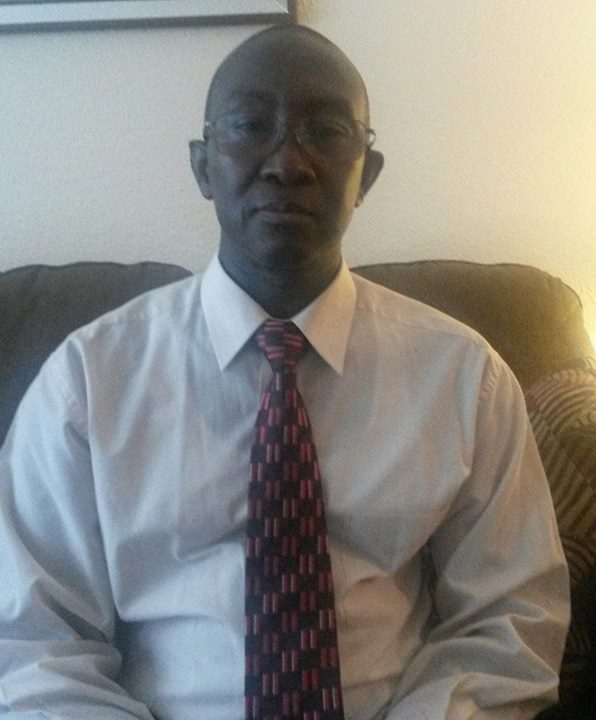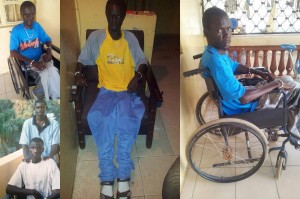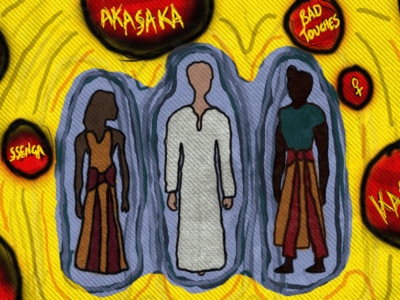
Omar Joof, exiled former student leader who led the demonstration in April 2000. Photo from his Facebook page.
April 10 and April 11, 2000 remain the darkest days in the history of Gambian student activism. On those fateful days security officials opened fire on student demonstrators, killing over a dozen, plus a journalist and a Red Cross volunteer as scores were left injured. But 15 years on, the perpetrators of those crimes remain at large.
From victims to their relatives and sympathisers, Gambians have taken to the Internet to share their feelings. Some are calling on authorities to investigate and bring to justice the culprits while most people seem to think the victims deserve official recognition in the form of a memorial day.

Some of the victims of April 2000 shooting in Gambia. Photo by Democratic Union of Gambians Abroad (DUGA). Used with permission.
On April 10, the now defunct Gambia Students’ Union (GAMSU) organised a nationwide students demonstration, protesting the death of Ebrima Barry, a student. Barry was reportedly beaten to death by officers of the fire service in Brikama, Western Division (now Western Region). After repeated demands by GAMSU, an autopsy report revealed that Barry died of “natural causes,” which the students dismissed as a “cover up”.
Around the same time, a thirteen-year-old school girl was reportedly raped by “uniformed men,” believed to be officials of the paramilitary Police Intervention Unit (PIU). The demonstrations started off in the Greater Banjul Area but turned violent and spread across the tiny country leading to mass arrests.
Mathew K. Jallow wrote a detailed account of what happened that day. He described how one young female student was shot in the back of her head as she was escaping and the bullet “exited from her forehead above her right eye”:
As students continued their peaceful march, the security forces were bracing for a fight, threateningly showing off their AK 47 machine guns. Soon tensions were high on both sides of the divide. Exchanges of insults between the protesting students and some security forces intensified, yet despite that, the least the students expected was what happened next. Unprovoked and in a deliberate show of brute force, some security personnel opened fire on the crowd of peaceful, unarmed students. When the crackly of machine guns’ fire finally fell silent after five minutes of frightening machine gun fire, small groups of students hovered over the bodies of the dead and dying. It was utter mayhem and pandemonium. One of the students, who lay dying, was a beautiful female student in St. Theresa’s school uniform. She lay sprawled on the ground close to the old Cooperative Union complex where she stumbled and fell trying to escape. A bullet entered the back of her head and exited from her forehead above her right eye. She twittered violently one more time and fell silent. Claesco Pierra was dead. The beautiful young girl with so much to live for was no more. Back at St. Theresa’s School, Jonfolo Ceesay, Ngone Jobe, Elizabeth Jatta and Ndungu Jallow, her four best friends, had no idea what had just happened. When it was over, sixteen lifeless bodies lay dead or bleeding profusely on the streets of Kanifing.
Sainey MK Marenah, an exiled Gambian journalist, called on the government to bring those responsible for the April 10 and 11 killings to justice:
Exactly 15 years since security forces brutally murder 14 Gambian students and a journalist following a peaceful protest by students demanding justice for two of their colleagues. The peaceful protest which turn deadly due to force use by armed security officers quelling the riots.
15 years since uprising, there is no sense of hope for the victims and their families. Therefore, I join various people celebrating the day to remind government of its constitutional responsibility to protect lives and properties of her citizens and ensuring that Justice is done and seen to be done in the case of the murder students. Justice delayed is Justice denied!!
Muhammed Lamin Juwara, who witnessed the shootings but managed to escape, named his fellow students who died:
I will never forget April 10th and 11th 2000 sitting for my final year exam on that fateful Monday at Ice man, coprative an west field junction when Yahya jammeh oders his agents to pulled the trigger of machine guns AK47 on my fellow students b4 my eyes..I was part of those who were lucky to escape from the bullets that day..these are the students that went to school that mornin an never return back home[1.Reginald Carroll 2.Karamo Barrow 3.Lamin Bojang 4.Claesco Pierra 5.Ousman Sabally 6.Sainey Nyabally 7.Ousman Sambene 8.Bakary Njie 9.Modou lamin Njie 10.Ebrima Barry 11.Wuyea foday Mansareh 12.Bamba Jobateh 13.Modou lamin Chune 14.Abdoulie Sanyang an Omar Barrow jounalist an red cross..may your soul rest in peace..
President Yahya Jammeh, Gambia's serving president, was abroad when the protest broke out, although many of the student survivors blame him for the attacks. A state commission of enquiry into the death concluded that some members of PIU personnel were “largely responsible” for the deaths and other injuries. But to date, no one has been tried for these crimes and no reparations paid to victims or their families.
Whether or not victims of and participants in the deadly April 2000 demonstrations will get justice remains a question for the future but for now they are refusing to let go.







1 comment